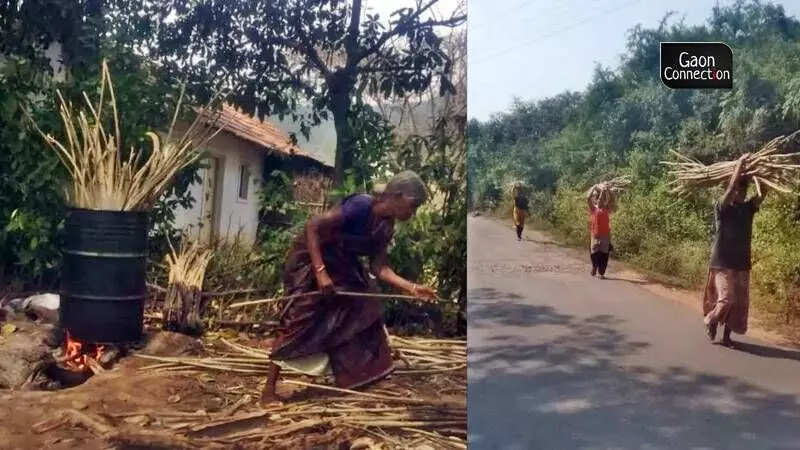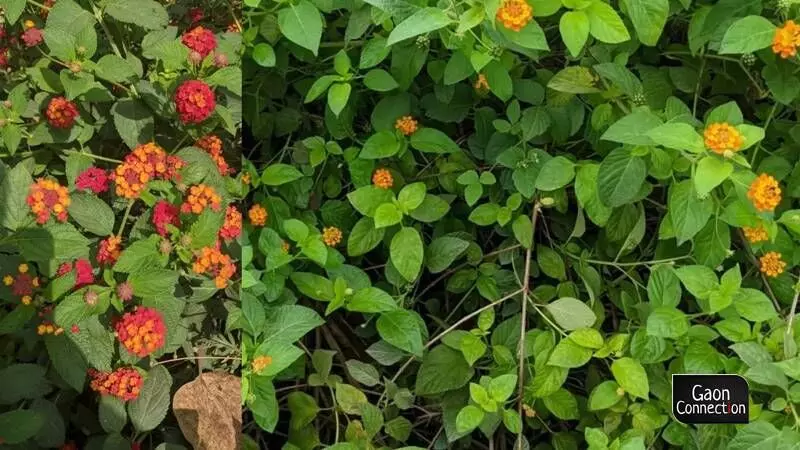Senguttaiyur (Coimbatore), Tamil Nadu
On a bright morning, Senguttaiyur basked in the sun, with its traditional thatched homes, and a few brick and mortar ones, lining either side of immaculate pathways.
Rangamma sat in the shady thinnai (sitout) of her home, watching over the bright green aruppu (albizia amara) spread out to dry in the sun. Arappu is said to contain antibacterial properties and is often used as a skin scrub and to wash hair.
“We collect the leaves, dry it out in the sun and powder it,” Rangamma told Gaon Connection. The powder is then packed and sold as a minor forest produce (MFP). Senguttaiyur, the Irula (also known as Irular) village falls in Coimbatore district, Tamil Nadu.
Many of the tribal women in Senguttaiyur like Rangamma are augmenting their family livelihood by collecting, processing and selling MFP such as the arappu and tamarind. Since most of them are goat herders too, they sell the goat droppings as fertilisers.

The 45-day course, which aims to add value to non-timber forest produce, is teaching the inhabitants of Sengattiyur Irula tribal village to make furniture out of the lantana. Photo by special arrangement.
But today, there is an additional buzz, and a certain impatience amongst the women who have been kept away from the forests by the lingering elephants. The delay in going into the forests has meant an interruption in a 45-day-training course both men and women of Senguttaiyur are attending.
The training, which kicked off earlier this year, involves gathering Lantana Camara, (rated as one of the world’s 10 most invasive species) from the forests, and turning it into furniture. Lantana has debilitated large tracts of forest lands in India threatening the nutrient cycle in the soil, and not allowing the local flora to grow. It is classified as a species of high concern meaning it has the possibility of causing great harm to the environment and the forest-based livelihoods of the Irula tribe.
“There are twenty of us who are undergoing training,” Selvi, who at 27 years of age is perhaps the youngest member being trained, told Gaon Connection. The women and men are learning how to make chairs, tables and shelves out of the lantana wood. And, they have almost exhausted the stock of wood they had and hence are waiting to go into the forests for more.
“The elephants have been walking right through the village too,” Vendhiamma, another resident of Senguttaiyur, told Gaon Connection. But, the 55-year-old did not seem unduly alarmed at this. It was a common enough occurrence, she smiled.

Augmenting their livelihood
Senguttaiyur nestles on the lower slopes of the Western Ghats within the Perianaickenpalayam Range of the Coimbatore Forest Circle falling in the Nilgiris Biosphere Reserve in Tamil Nadu. It is home to 40 families belonging to the Irula tribe. The Karamadai town panchayat it comes under is more than 20 kilometres away.
There are 36 scheduled tribe communities in all in Tamil Nadu, the Irulars are identified as a Particularly Vulnerable Tribal Group, along with the Toda, Kota, Kurumbas, Paniyan and Kattunayakan tribes.
According to the 2011 Census, there are 23,116 Irular households in Tamil Nadu, and their numbers are depleting. They are a denotified tribe.
The 45-day course, which aims to add value to non-timber forest produce, is teaching the inhabitants of Sengattiyur Irula tribal village to make furniture out of the lantana.
The catalyst for the lantana project is the outcome of seven years of work put in by social worker Kamini Surendran. “I was doing my PhD and my research paper was on Empowerment and sustainable development of Senguttaiyur village Irular tribal women. I surveyed many villages in this area, and found this village to be really remote and underdeveloped… and all the families here were below the poverty line,” the 57-year-old told Gaon Connection.

Each training capsule, like the one at Senguttaiyur, gets a fund of about six to seven lakh rupees, and this includes a stipend of Rs 300 a day for all those being trained. Photo by special arrangement
Surendran saw the lantana project being implemented by Amrita Vishwa Vidyapeetham in other tribal villages in the Siruvani Hills in Coimbatore. She approached the university to find out if the same could be done in Senguttaiyur as well, and the project was launched there in January this year.
Developing sustainable livelihoods
The Ministry of Environment, Forest and Climate Change (MoEFCC) has funded the Senguttaiyur project through ENVIS, its Environmental Information System, in partnership with the Amrita Vishwa Vidyapeetham in Coimbatore. ENVIS disseminates scientific, technical and semi-technical information on various issues related to the biological invasion (invasive alien species).
One of its objectives is to promote Green Skill Development Programmes (GSDP) to skill people in the environment, forests and wildlife sectors, and create sustainable livelihood options for tribal communities and at the same time contribute to forest and biodiversity conservation.
“We have worked with seven Irula settlements around Coimbatore since 2011,” Maya Mahajan, centre co-ordinator for ENVIS and associate professor at Amrita University, told Gaon Connection. The centre began community mobilisation, first from the Ministry of Science and Technology, and then from the environment ministry.
“Using chemical methods to control or eliminate the invasive lantana is tedious, time consuming and expensive and not good for the environment. So, we experimented with the help of local artisans, and found that the lantana was strong enough to be made into furniture, and began the programme,” Mahajan said.
Each training capsule, like the one at Senguttaiyur, gets a fund of about six to seven lakh rupees, and this includes a stipend of Rs 300 a day for all those being trained. “It is a win-win situation that provides a sustainable livelihood for the tribals and at the same time conserves forests,” Mahajan said.
There are plans afoot to replicate the lantana project across the country. And tribal communities in Dahanu in Maharashtra and Wayanad in Kerala will soon be having the training capsules, she said.
Process of making lantana furniture
Meanwhile, in Senguttaiyur, Rangasamy Kumara and Veerasamy from the Irula villages of Singampatti and Mullamkadu respectively in the Siruvani Hills are demonstrating to the women how to measure and cut twine that will be wrapped around the edges of the chairs. Kumara and Veerasamy were trained in making lantana furniture several years ago and they are now master trainers for new batches such as the one here in Senguttaiyur.
“We are divided into five groups of four members each and each group is responsible for learning and then making one piece of furniture,” 27-year-old Selvi explained, pointing to a couple of arm chairs, a centre table, some peg tables, in different stages of completion.
“We are yet to finish the three-seater sofa,” Selvi said, inviting Gaon Connection inside the cool dark interior of her father’s home to show us a big bookshelf standing against the wall. Usually, the entire family pitches in to help, she said.
The women go into the forests looking for lantana and it takes them two to three hours to pick and cut them, after which they bring back all that they can carry as a head load.
Most of the action in Senguttaiyur, happens under the shade of a massive banyan tree, with the stone idols of gods of the Irulars, under it, looking on. On one side is a big black drum filled with water to the brim with lantana wood in it, boiling on a fire.

Lantana Camara is rated as one of the world’s 10 most invasive species.
“We allow it to boil for about two hours. We then take them out, strip off the outer bark, dry them and they are ready to be used,” 50-year-old Lakshmi explained. Depending on the gathering and processing of the wood, it could take anything between two to three days to finish a chair, she said.
Marketing the lantana furniture
“The environment ministry ordered nearly a lakh and a half rupees worth of lantana furniture the tribal community from one of the villages in the Siruvani Hills made. The marketing strategies are still evolving,” Mahajan said.
Marketing is a very important factor in training programmes, said Mahajan. Only then can they be sustained, she added.
For Senguttaiyur too a marketing strategy has been put in place. According to Surendran, the ladies wing of the Federation of Indian Commerce and Industry (FICCI), the FICCI Ladies Organisation (FLO), Coimbatore Chapter, has taken the onus of marketing the finished furniture that is made here through a furniture outlet belonging to one of FLO.
“The Senguttaiyur villagers have access to forest resources and have traditional skills for processing of NTFP, but they lack support through training that can give them a boost,” Mahajan said and hoped the fact that their furniture would be sold, will give them the impetus to continue.
“We will inform you when the furniture is ready. Please come for the exhibition we will have then,” Lakshmi beamed. “Of course, it all depends on when we complete the three-seater sofa, and that all depends on what the elephants decide,” she said.


















